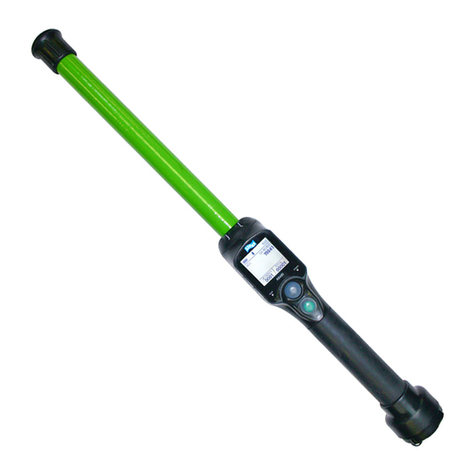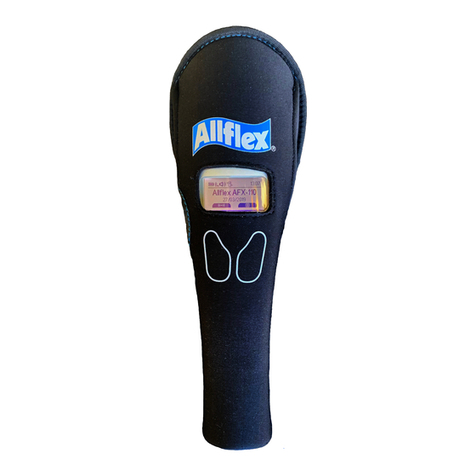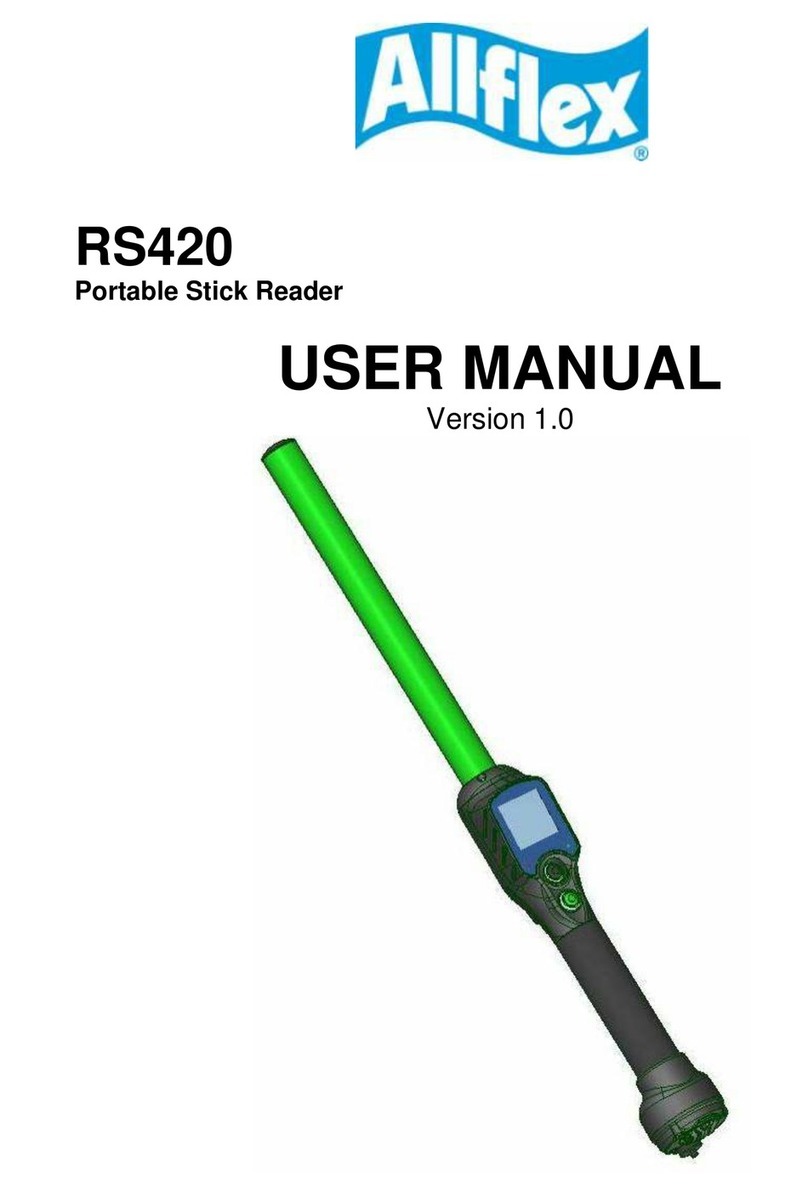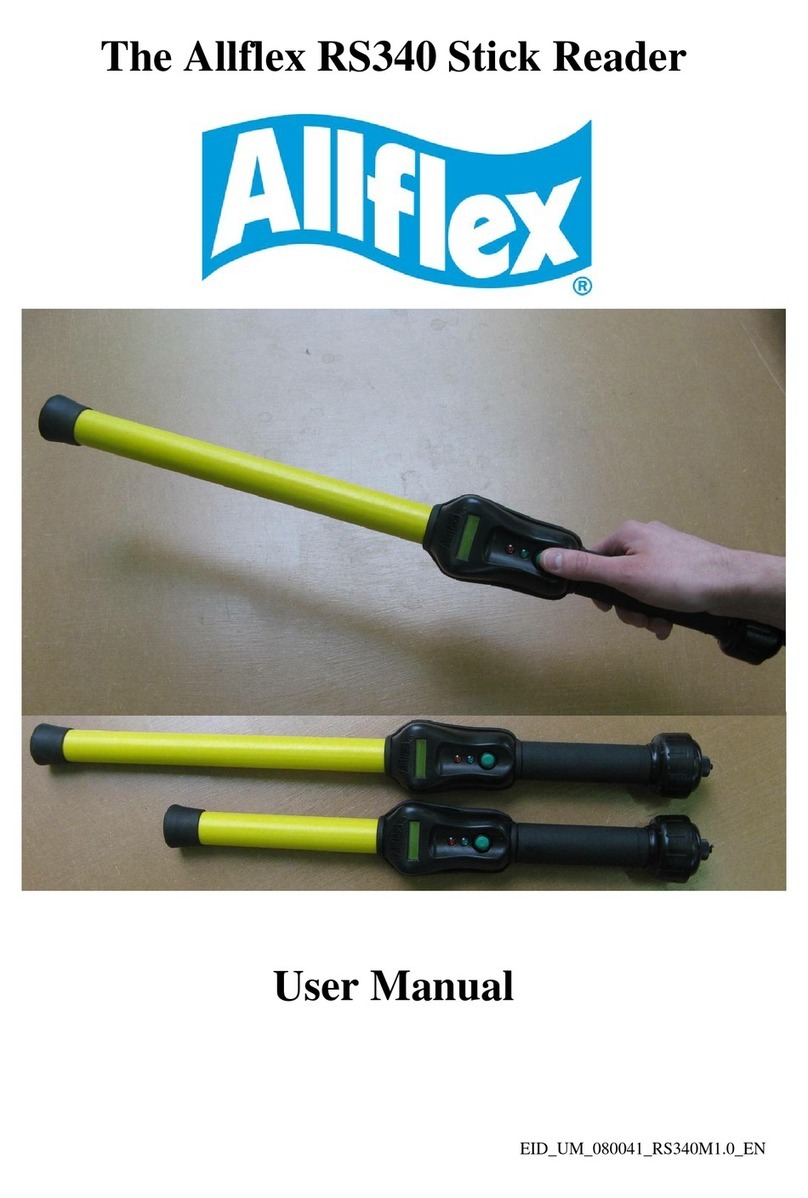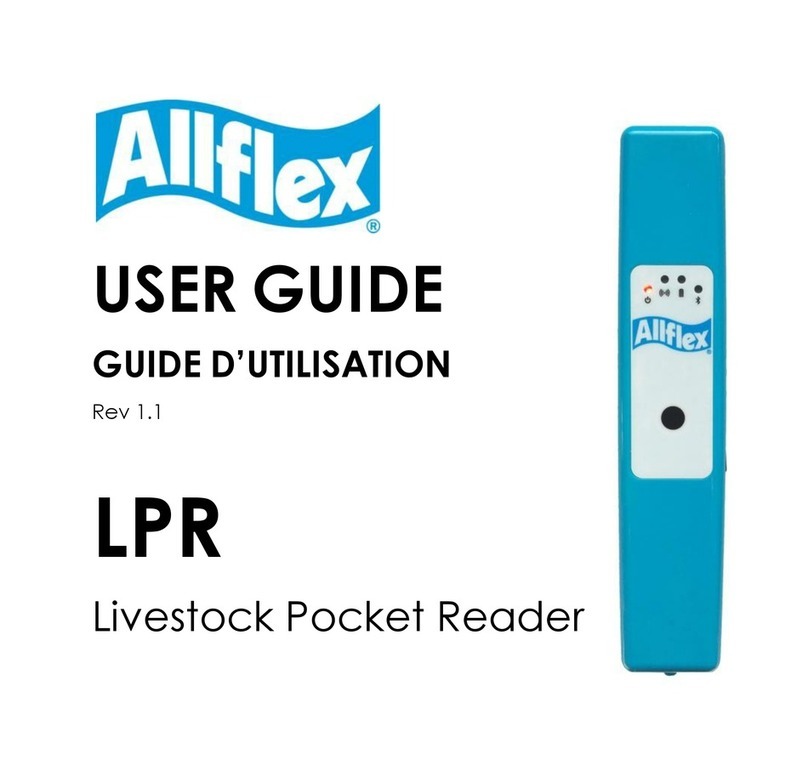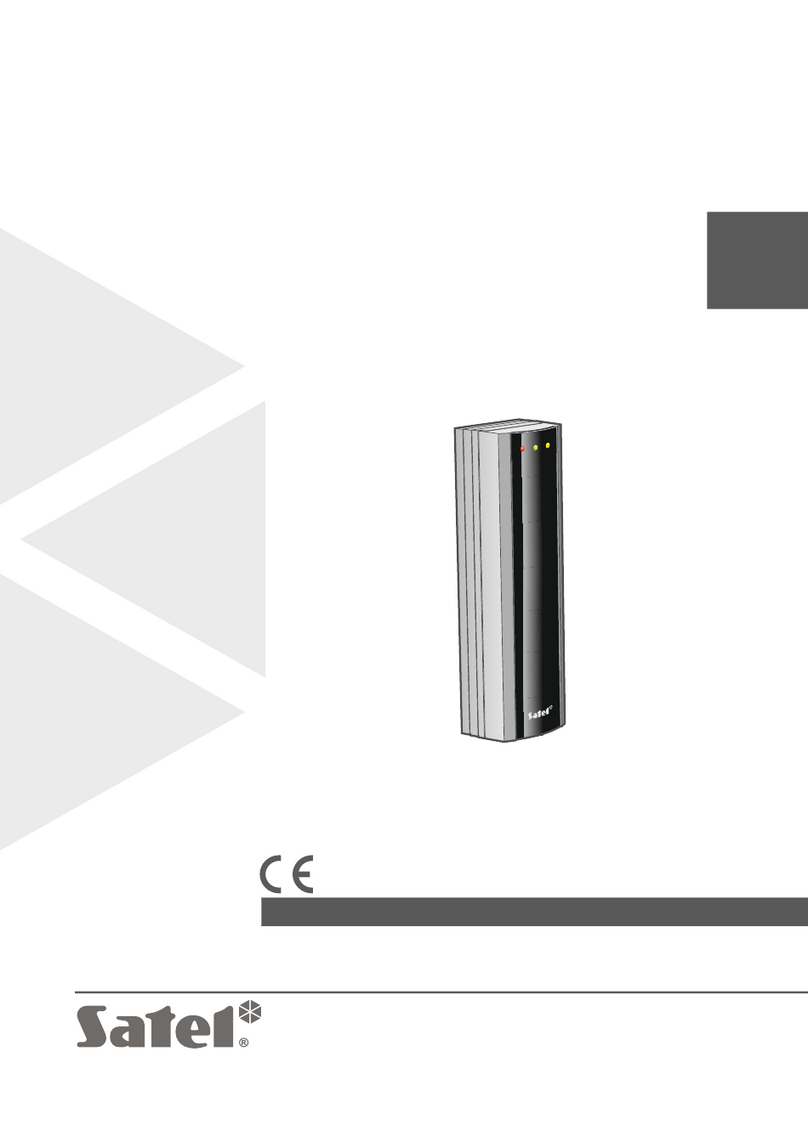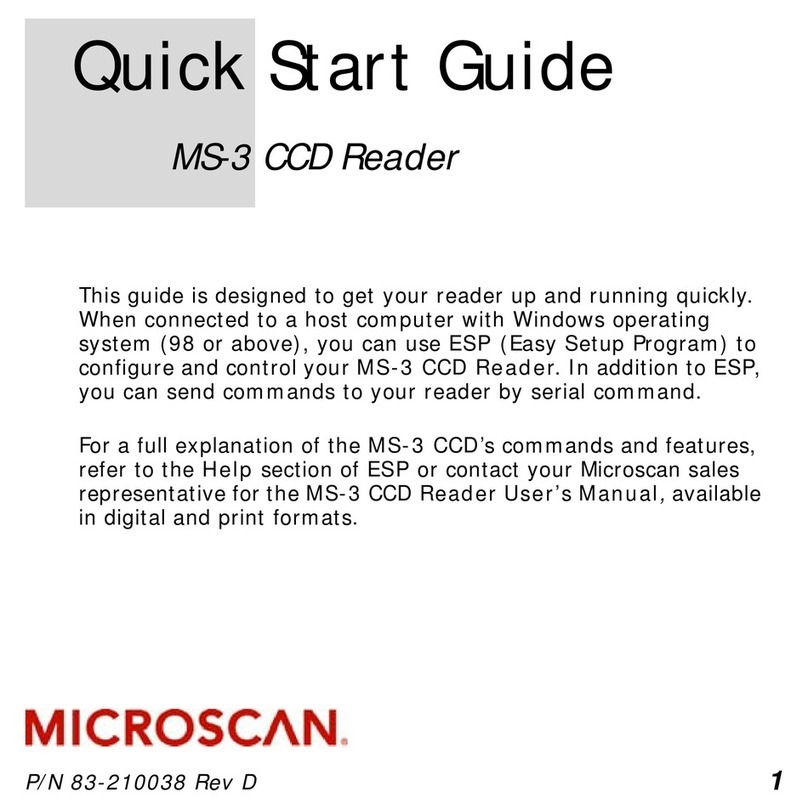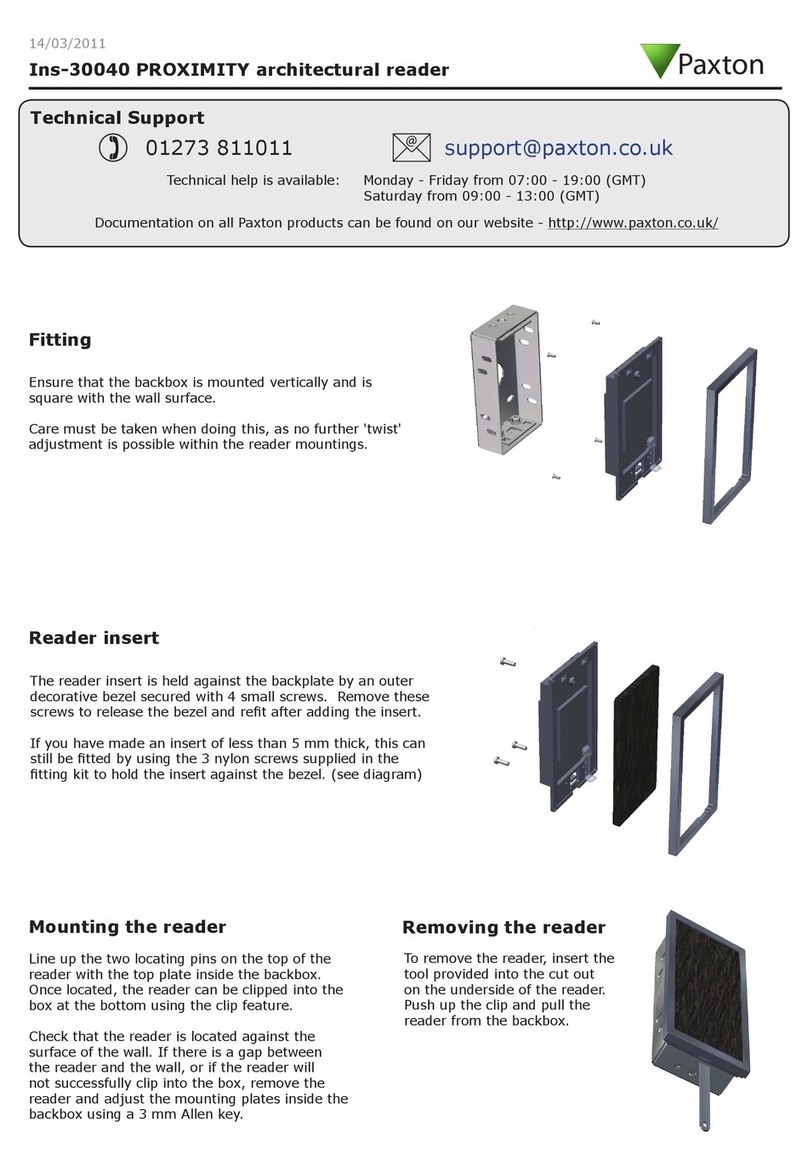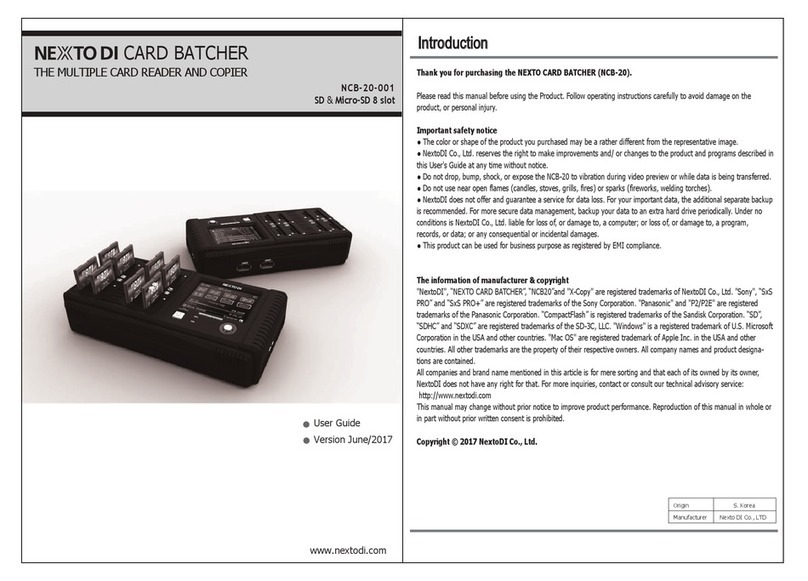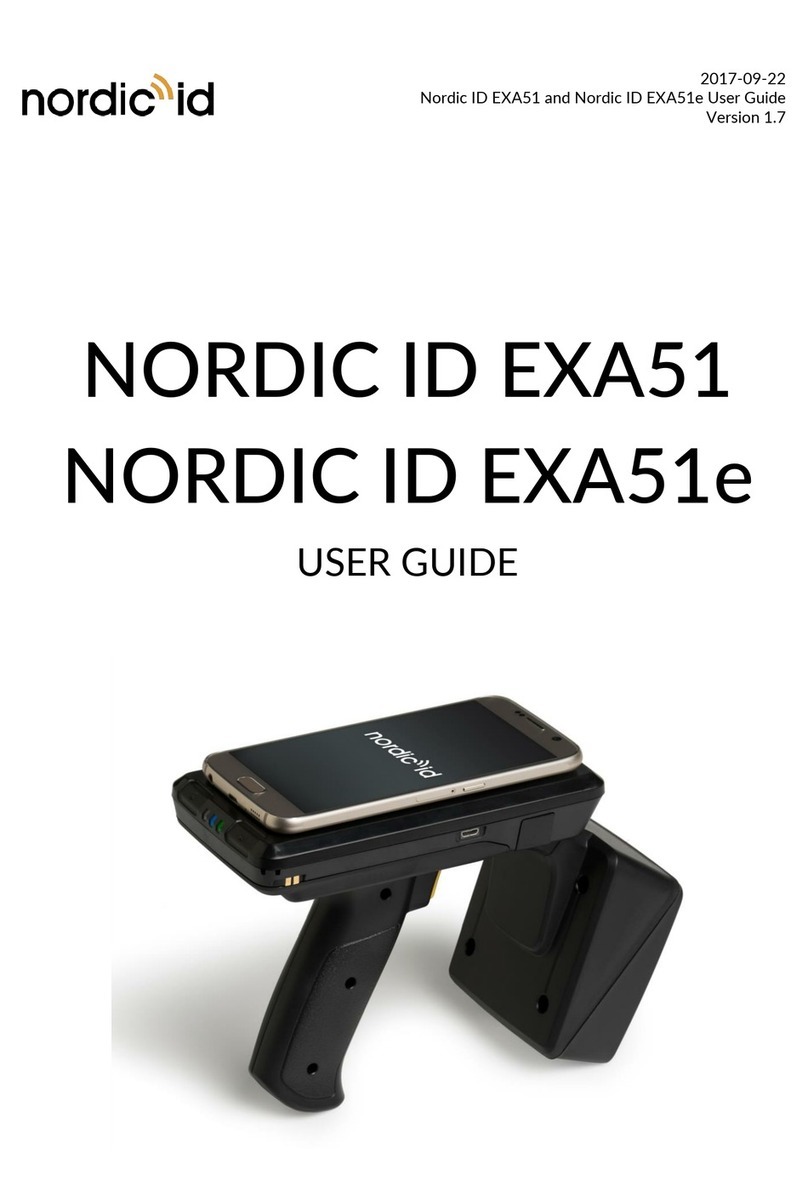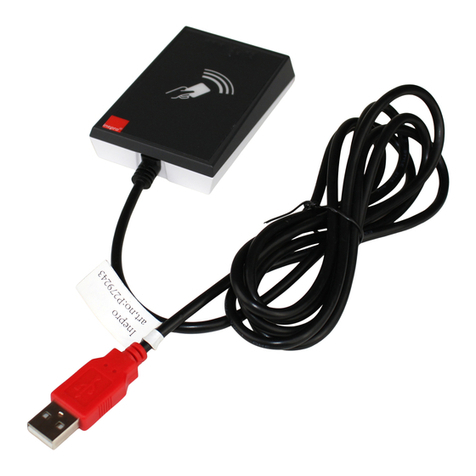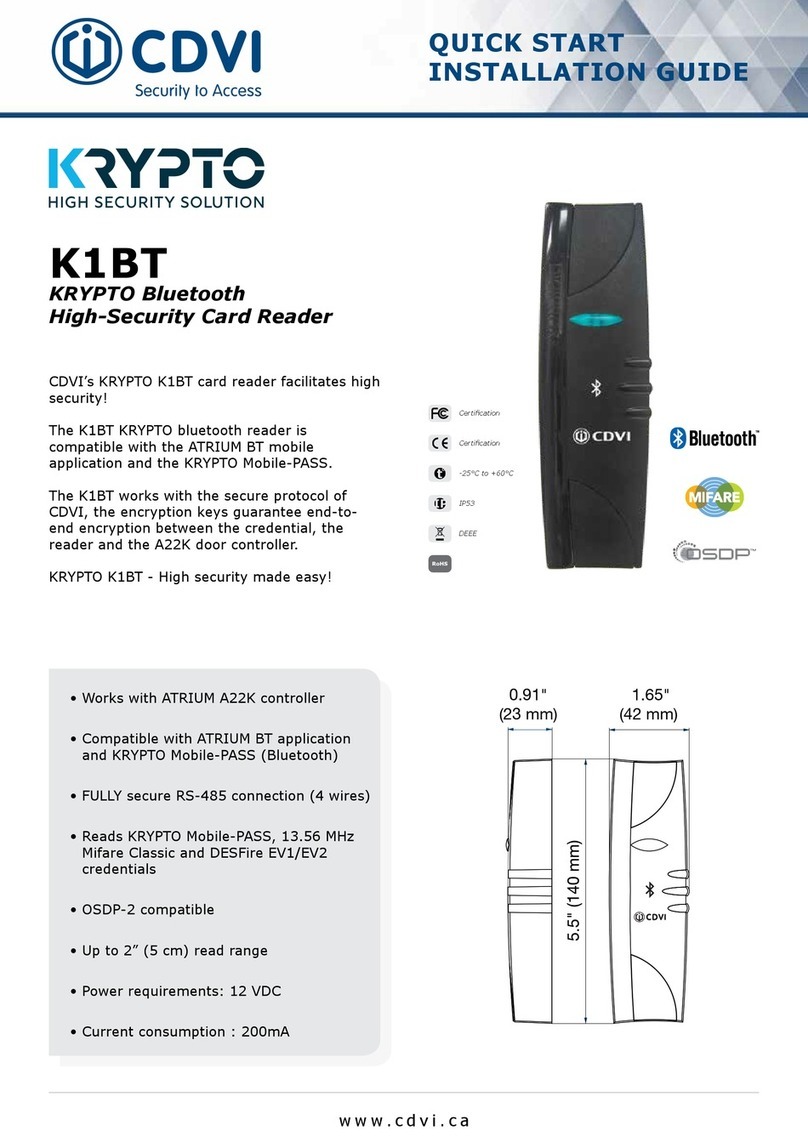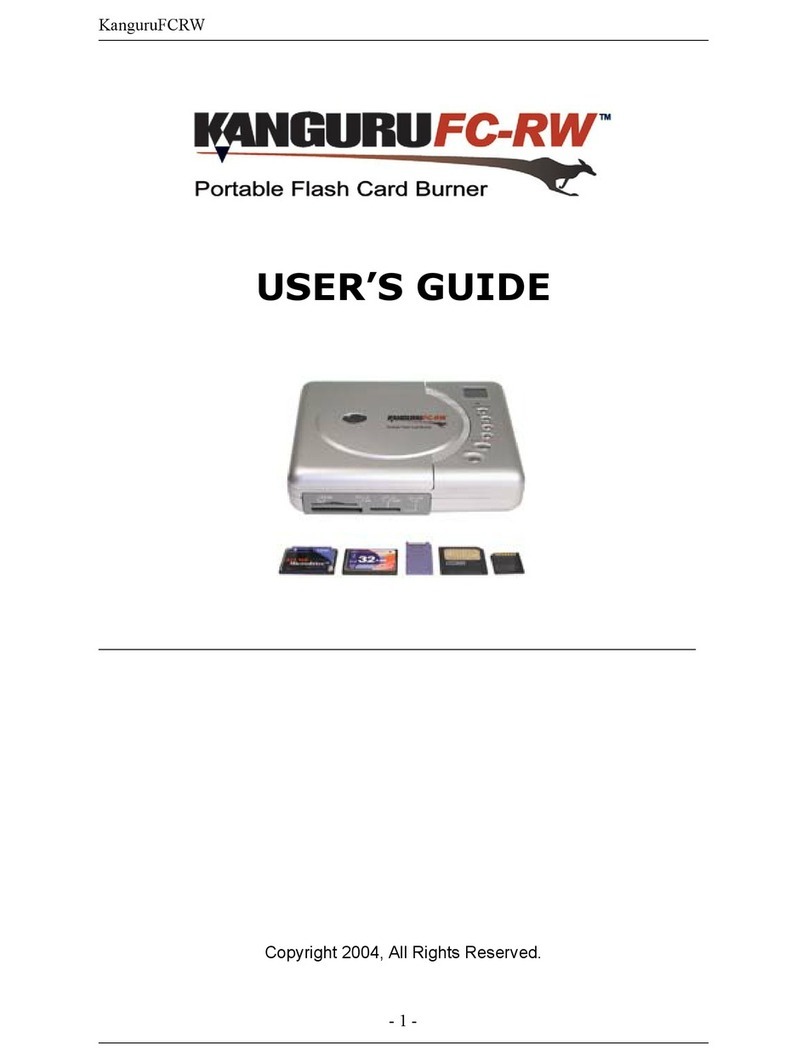Allflex 930009-001 Programming manual

Allflex ISO Compatible RF/ID Pocket Reader Feature/Item Description of Use
READ Button Turns Reader ON from OFF state
Activates transponder reading from ON state
Selects certain option alternatives in Options Menu
MENU Button Activates Options Menu / Selects Options Menu Category
SCROLL UP/SCROLL
DOWN Buttons
Navigates Options Menu
(Press both buttons simultaneously to turn off unit)
2x8 Character LCD Displays transponder ID Code information, Reader status, and Options
Menu selections
Red LED Indicator Lights when valid transponder ID Codes are detected
(optionally lights with Options Menu selections)
Antenna Coil Transponder coil axis should be coaxial or parallel to Reader antenna axis
for maximum reading distance (mounted inside enclosure – see Figure 3)
Battery Compartment Accepts single 9 volt alkaline or nickel-cadmium battery (bottom)
Equipment Label Provides model, serial number, and agency certification notices (bottom)
Enclosure Compact ergonomic case
Quickstart Instructions
(Rev A1 01Jun99 / Software V1.00+)
These instructions guide the user through the basic setup, configuration, and operation
of the Allflex Pocket Reader, P/N 930009-001, an RF/ID scanner capable of reading
and displaying ISO HDX and FDX-B type transponder identification codes.
Preparing For Use
Unpacking
The Pocket Reader is shipped in a box with this instruction guide and one 9 volt
alkaline battery. Remove the reader and battery from the box, and follow the
directions contained in this guide for battery installation, setup, and operating
instructions. Transponders (not supplied with Reader) are helpful in verifying the
configuration and operation procedures described in this guide.
Setup
The Pocket Reader requires only installation of the 9 volt battery in order to begin
reading transponders. The Reader also permits the user to configure several options
that control its functions and ID code presentation format.
Pocket Reader User Interface
The figure below illustrates the Pocket Reader’s features that are instructive to its
operation and use. Each feature and its corresponding function are described in the
accompanying Table 1 on the following page.
Battery Installation Instructions
The Pocket Reader is supplied with one 9 volt alkaline type disposable battery. A
variety of battery technologies, both disposable and rechargeable types, can be used.
Table 2 lists one manufacturer’s compatible battery types, and the estimated service
life each type will provide in use with the Pocket Reader.
Figure 1 - Pocket Reader Features and User Interface
Table 1 - Pocket Reader Features and Descriptions of Use
BATTERY
COMPARTMENT
2x8 LCD
ANTENNA
Red LED
ENCLOSURE
SCROLL UP
SCROLL DN
MENU
READ
To install or replace the battery (ensure Reader is turned off before proceeding):
• Turn the Reader over so that the equipment label is visible. Push down gently on
the small ribbed spot just beneath the label and push laterally away from the label.
• When the battery compartment cover has slid open approximately 10mm, it can be
removed from the channel in which it fits to expose the battery compartment.
• Install the 9 volt battery observing the polarity orientation etching which appears
in the bottom of the enclosure.
Note:Incorrect installation of the battery will not damage the reader. However, the Reader
will fail to operate unless the battery polarity is correctly oriented.
• Reposition the battery compartment cover and snap it into the channel
approximately 10mm from the closed position. Once in the channel, press down
gently on the ribbed spot and slide the cover back into the fully closed position.
Note: FDX-B reading distance performance may be slightly less when a nickel cadmium type
battery is installed in the reader. Both HDX and FDX-B reading distance will gradually
2
1

deteriorate as any type battery is discharged through normal use. The Pocket Reader provides a
Low Battery indication on its LCD display when the battery requires charging or replacement.
Note: The battery is checked each time the reader is powered on. If the battery life is nearing
its end, a LOW BATTERY indication will automatically appear on the LCD indicator. If the
battery has become severely discharged, the Reader will fail to power up altogether.
Note: Rechargeable batteries must be charged in compatible external charging apparatus.
Note: The Pocket Reader turns itself off automatically after 30 seconds (or the user selected
Options Menu alternative time). The Reader can be turned off manually by simultaneously
pressing the SCROLL UP and SCROLL DOWN keys.
Note: Actual number of transponder reads per battery life will vary with the pattern of use of
the Reader. Numbers shown in Table 2 are based on 1 second scan intervals to level at which
HDX transponder read distance is diminished to approximately 1/2 initial distance.
Figure 2 - Pocket Reader Functional Sequence
Note: When battery life has been exhausted to a point at which battery replacement is required,
the LCD readout will indicated “LOW BATTERY / POWERING DOWN” and will
automatically turn off.
Table 2 - Recommended Battery Types (all Eveready/Energizer®)
Type Number Chemistry Capacity mAH Est. No. of Reads
1222 (Heavy Duty) Zinc-Manganese < 50 300
522 Alkaline 600 10,000
L522 Lithium 1200 20,000
CH22 * Nickel-Cadmium 120 3,000
Note: Nickel Cadmium is rechargeable battery type.
Operating and Using the Pocket Reader
Activating the Pocket Reader
After installing the battery, the Pocket Reader is ready for use. The Reader is activated
from its normally OFF state by momentarily pressing the READ button. Upon
depression of this button, the Reader is turned ON, and an indication of this state is
enunciated by momentary flashing of the red LED visual indicator, beeping of the
audible indicator, and displaying of READER READY on its LCD indicator.
Note: If the LAST TAG option in the Options Menu has been set On, and a transponder has
been previously read, the LCD indicator will show the ID code number of the last transponder
tag that was read.
Reading a Transponder Tag
The Reader is immediately ready for use once it is turned on. Transponder scanning is
performed by pressing the READ button. If the READ button is pressed momentarily,
scanning will be active for a default interval of 3 seconds. If a transponder is detected
during this time, its ID code will be displayed on the LCD, and the LED indicator will
flash once, and the audible beeper will beep once. If the same ID code is read
repetitively, the LED and beeper will flash and beep twice. If no transponder is
detected after 3 seconds of scanning, the LCD will indicate NO TAG FOUND, and
scanning will cease. Pressing READ again initiates the scanning sequence.
Alternately, the READ button may be pressed continuously until the tag is read.
Scanning automatically stops upon ID code acquisition, and the READ button must be
released and pressed again to perform a subsequent reading operation. See Figure 2
for a graphical illustration of the Pocket Reader’s operating sequence.
Reading Transponders
READER OFF
(PWR DN)
READER ON
(RESET)
OPTIONS
MENU
Time Off
Auto - 30 Sec
READ
Note: Reader Time Off
Interval timing starts after
Exciter On Timer
Expires
Auto -
3 Sec
READ
READ
Time intervals shown are default values,
and can be changed using Option Menu.
Ranges/Resolution:
Time Off: 20 - 60 Sec / 5 Sec
Read Time: 1 - 5 Sec / 1 Sec
Time Off
Auto - 30 Sec
Time Off
Auto - 30 Sec
OPTIONS MENU Screen can be accessed
by pressing MENU from the following screens:
- READER READY
- NO TAG FOUND
- 982H009000031227 (ID Code Display)
READER OFF can be invoked by pressing
both SCROLL buttons simultaneously
LAST TAG = ON
Tag ID
Found
MENU
MENU
MENU
READ
READ
READ
READ
LAST TAG = OFF
Tag ID
Not Found
Pocket Reader State Diagram
READER
READY
READING
( () )
NO TAG
FOUND
982H0090
00031227
Prior to reading transponders in situ, it is recommended that the Reader be checked
with test transponders to ensure satisfactory performance. The user should have
4
3

available spare transponders of the types that the Allflex Pocket Reader is capable of
reading for this purpose. The chart below provides nominal read distance performance
that can be expected when the transponder is optimally oriented to the Reader.
Table 3 - Nominal Read Range Performances (with new 9V alkaline battery)
Manufacturer Transponder Description Read Range (cm)
Allflex FDX-B (ISO) 12mm Glass Implantable 6
Allflex FDX-B Plastic Eartag 10
Allflex HDX Plastic Eartag – High Performance 15
Allflex HDX Plastic Eartag – Light Weight 12
Allflex HDX 23mm Glass Implantable 9
Allflex HDX 31mm Glass Implantable 11
Note: In order to read a transponder, position the transponder as shown in Figure 3 below
within the read range specified in Table 3. Press and release the READ button. The Reader
will search for a transponder for 3 seconds (the factory set default value). If the transponder is
detected during this interval, the Red LED will flash, the audible beeper will sound, and the ID
Code will be displayed on the LCD readout. If no transponder is detected during this search
interval, there will be no audible/visual indication, and the LCD will display NO TAG FOUND.
When any tag number is read more than once, the LED and beeper indication will be a double
flash/beep indication. Holding the READ button down permits continuous scanning.
Note: When reading installed transponders whose orientation cannot be ascertained, the
reading distance may be less than those listed in Table 3. The Reader may need to be moved
and its orientation may need to be changed in order to obtain a reading. Generally, reading such
non-visible (implanted) transponders will require such Reader movement.
Figure 3 - Optimal Read Range Transponder Orientation
Interpreting the Visual ID Codes
The Portable Reader is capable of reading the ISO HDX and FDX-B transponder
technologies, and it can be configured via the Options Menu to display the
corresponding ID Code information in 4 different formats (see Figure 4). Using the
Options Menu, the Reader can be configured to display a transponder’s Manufacturer
Code and the Identification Code, or only its Identification Code. Furthermore, the
transponder’s information can be displayed in either decimal (0 > 9) or in hexadecimal
(0 > F) representation.
Note: The Manufacturer’s Code is displayed only for ISO compliant HDX and FDX-B
transponders that contain a decimal value in the range of 900 to 999, per ISO 11784
requirements, and per ICAR assignment. A value less than 900 is also displayed, but represents
a Country Code per ISO 11784 and ISO 3166.
Table 5 - Manufacturer and Country Code Designations
Manufacturer/
Country Code
Interpretation
900 > 999
(384 > 3E7 Hex)
ISO Compatible HDX or FDX-B type transponder
Manufacturer Code per ISO 11784 and ICAR assignment ( Note: 999
is reserved for universal use to designate a prototype transponder).
001 > 899
(001 > 383 Hex)
ISO Compatible HDX or FDX-B type transponder
Country Code per ISO 11784 and ISO 3166
(none) or IND 16 digit (decimal) code or 13 digit hexadecimal code - Allflex
Industrial
AFLX Allflex proprietary type transponder (reusable)
Note: The Manufacturer Code information appears on the LCD as the left-most 3 digits or 4
characters on the top line. When the LCD format has been set for hexadecimal representation, a
lower case “h” precedes the 10 digit ID Code information, except for HDX Industrial format
type transponders.
Note: Industrial coded HDX transponder types exhibit either 16 (decimal) or 13 (hexadecimal)
characters as shown in Figure 4. It is not possible to display the 4 digit application code that is
embedded within another field in the transponder.
Glass Implant
Transponder
Pocket
Reader
Ferrite Antenna
Eartag/Disc
Transponder
5 6

Figure 4 - LCD Display Formats Transponder Type - HDX transponders generally exhibit greater reading distances than FDX-B
transponders of comparable size.
Decimal ID Code
with Mfr/Cntry Code
Hexadecimal ID Code
with Mfr/Cntry Code
Decimal ID
Code Only
Hexadecimal
ID Code Only
Transponder
Type Legend
LCD Display Formats for Valid Transponder Types
LCD FMT=
DEC/MFR
982I0090
00027669
982H0000
01039883
00000000
17838943
AFLX0091
23456789
LCD FMT=
HEX/MFR
3D6I-h02
18718615
3D6H-h00
000FDDD9
IND00000
0110335F
AFLX-h02
18711A00
LCD FMT=
DEC
----0090
00027669
----0000
01039883
00000000
17838943
----0091
23456789
LCD FMT=
HEX
-----h02
18718615
-----h00
000FDDD9
IND00000
0110335F
-----h02
18711A00
DISPLAY
FORMATS
ISO
FDX-B
ISO HDX
HDX
IND'TRL
NON-ISO
HDX
Proximal Metallic Objects - Metal objects located near the transponder or Reader can attenuate
and distort the electromagnetic fields generated in RFID systems, and thus diminish read
distance performance.
Electrical Noise Interference - RFID transponders and readers use electromagnetic signals as a
premise of operation. Other electromagnetic phenomena – radiated electrical noise from
computer displays, for example – can interfere with the transmission and reception of RFID
signals, and consequently reduce reading distance.
Transponder/Reader Interference - Multiple transponders within the sensing range of the
reader, or other readers emitting excitation energy in the immediate vicinity will adversely affect
the reading performance or prevent operation of the Pocket Reader.
Figure 5 - Options Menu Navigation
READER
READY
OPTIONS
MENU
FDX-B
*ON OFF
HDX
*ON OFF
XPNDR
TYPE
MFR CODE
*ON OFF
LCD FMT
*HEX DEC
ID CODE
DISPLAY
MENUBEEP
*ON OFF
BEEP/LED
*ON OFF
LAST TAG
*ON OFF
READTIME
3 SEC
TIME OFF
30 SEC
READER
SETUP
SCR DN MENU SCR DNSCR DN MENUMENU
MENU
MENU READ
READ
READ
SCROLL
UP
SCROLL
DOWN
MENU MENU
MENU MENU
NOTES:
1. If both "XPNDR TYPE" items are set to "OFF", Default Mode (HDX
and FDX-B "ON") is automatically set.
2. All option menu screens time-out to "READER READY" mode if no
keys are pressed for 5 seconds.
READ
READ
S/W V1.00
H/W V1.00
VERSION
INFO
SCR DN MENU
Reading Performance
RFID Readers are most frequently assessed with respect to performance by reading distance.
The reading distance performance of a Reader is principally affected by the following effects:
Transponder Orientation - For maximum reading distance, the axes of the transponder and
reader antenna coils must be oriented coaxially.
Transponder Quality - Each manufacturer’s transponder differs in (a) the amount of exciter
signal energy necessary to sufficiently operate the transponder’s internal circuitry, and (b) the
signal level of the ID Code information that is returned to the reader. Consequently, it is normal
for transponders of a common type (FDX-B, for example) made by different manufacturers to
exhibit different read range performance characteristics.
Transponder Motion - Most portable readers have small antenna geometries, and consequently
small effective “reading zones”. Portable readers are generally designed for reading
transponders under quasi-static conditions. Transponders that are moving quickly past the
reader may not be present within the reader’s read zone sufficiently long for all the ID Code
information to be obtained.
Transponder Size - Physically larger transponders generally contain larger receiving coils which
produce longer reading distances than smaller transponders.
8
7

Default Option Settings
The Options Menu (see Figure 4) provides the user with means to configure the Pocket
Reader in a manner that best suites the user and the Reader’s intended application.
• Press the MENU button until the desired Option Category listed in Table 5
appears on the LCD.
• Press SCROLL UP or SCROLL DOWN until the Option Item appears on the
LCD
• Press the READ button to select the desired option setting
The Pocket Reader is shipped from the factory with these options set in the default
state. An abbreviated listing of the principal options is provided in Table 5.
Table 5 - Option Menu Categories, Items, and Default Settings
Option Category Possible Settings Default Setting
XPNDR
TYPE
Each of 2 transponder types may be set ON or
OFF
HDX - ON
FDX-B - ON
ID CODE
DISPLAY
Decimal or Hexadecimal
Manufacturer/Country Code ON or OFF
Last Tag - ON or OFF
Decimal
Mfr Code ON
ON
READER
SETUP
Time Off - 20 to 60 Sec
Read Time - 1 to 5 Sec
Beeper/LED - ON or OFF
Menu Beep - ON or OFF
30 Seconds
3 Seconds
ON
ON
VERSION
INFO
None – information only SW V1.00
HW V1.00
Allflex Worldwide Sales Offices
Allflex Europe Allflex USA, Inc. Allflex Australasia
ZI. de Plagué P.O. Box 612266 Private Bag 11003
Route des Eaux, B.P. 70 Dallas/Ft. Worth Airport Palmerston North
F-35502 Vitre Cedex, France Texas 75261-2266 New Zealand
Tel 33 (0)2.99.75.77.00 Tel (972) 456-3686 Tel 64 (06) 356-7199
Fax 33 (0)2.99.75.77.29 Fax (972) 456-3882 Fax 64 (06) 358-5982
http://www.allflex-boulder.com
FCC ID: NQY-930009
This device complies with Part 15 of the FCC Rules. Operation is subject to the following two
conditions: (1) this device may not cause harmful interference, and (2) this device must accept any
interference received, including interference that may cause undesired operation.
This device has been tested and meets the Electromagnetic Compatibility (EMC) requirements of
EN50082-1 and EN50022 for the CE Declaration of Conformity (DoC).
Product Safety Notices
Technical Specifications
GENERAL
RFID Compatibility: ISO 11784 & 11785 HDX and FDX-B and Industrial HDX
Form Factor: Portable Handheld ABS Plastic Enclosure
User Interface: Single “On/Press to Read” Activation Button
Menu & Scroll Up/Down Option Select Buttons
16 character (2x8) LCD display
Audible Beeper and Red LED “Read” Indicators
ID Code Display Format Decimal or Hexadecimal
Memory: Holds last ID Code in memory and on display indefinitely until next
read
Battery Power: 1 9V Alkaline Battery (disposable), or
1 9V Ni-Cad Battery (externally recharged)
Agency Certifications:
(PENDING)
Electromagnetic Compatibility - FCC Part 15 Class A, and CISPR 22
(EN55022), and EN50082-1
Product Safety - UL1950, IEC950 (CE Marked)
ISO Certification (when requirements published)
PHYSICAL/ENVIRONMENTAL
Dimensions: 125.5mm L x 70mm W x 24mm H (4.9” L x 2.75” W x 0.94” H)
Weight: 0.18 kg. (6.5 oz.) with alkaline battery installed
Material: ABS UL94 HB Plastic
Color: Black
Operate Temperature +5ºC to +40ºC (IEC68.2.1/.2)
Storage Temperature -10ºC to +55ºC (IEC68.2.1/.2)
Humidity: 0 to 95% (IEC68.2.56)
Altitude: -100 to +3,000 meters
Mechanical Shock: Per IEC 68-2-27
Vibration: Per IEC 68-2-6
Hermeticity: IP-50 (dust resistant / no protection against water) per IEC 529
RELIABILITY
MTBF: 50,000 hours
MTTR: 0.5 hours
Expected Life: 5 years, minimum
PERFORMANCE
Read Distance: 6cm (typical - Allflex 11.5mm FDX-B transponder)
15cm (typical – Allflex HDX eartag)
Reading Orientation: 0º to 45º with less than 10% range decrease
Read Error Rate: Less than 1 in 106
Read Cycles/Battery: 10,000 - Alkaline (disposable) (based on 2 second read intervals)
3,000 - Ni-Cad (rechargeable)
Battery Disposal Information
The disposal of exhausted rechargeable and non-rechargeable batteries is regulated by local laws, and such
laws vary significantly among countries worldwide. All batteries must be disposed of in a manner compliant
with the local requirements, and proper compliance is entirely the responsibility of the owner and/or user of
the Pocket Reader.
9 10
L
i
ste
d
UL1950
E189922
Table of contents
Other Allflex Card Reader manuals
Popular Card Reader manuals by other brands
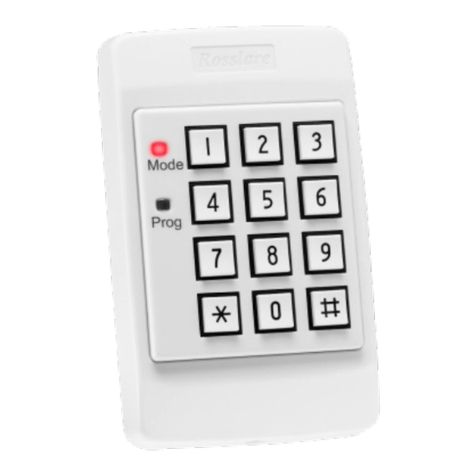
Rosslare
Rosslare AY-D09M Installation and programming manual
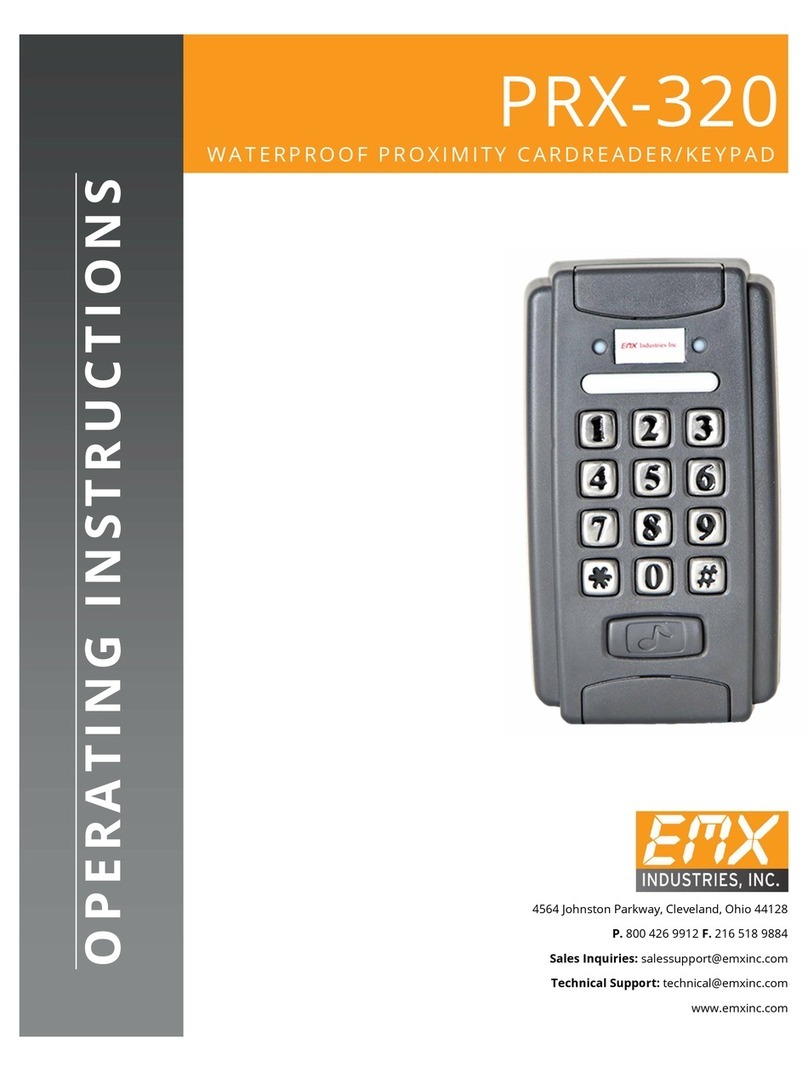
EMX Industries
EMX Industries PRX-320 operating instructions
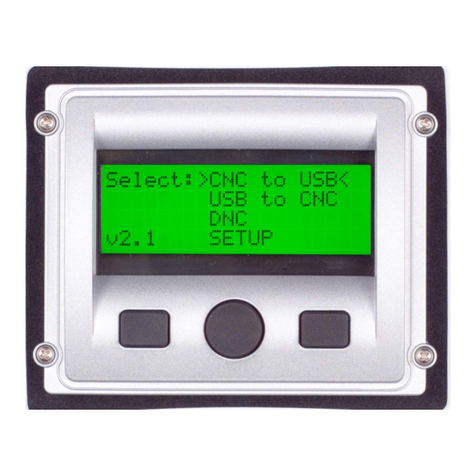
Calmotion
Calmotion USBCNC-SW Mount instructions
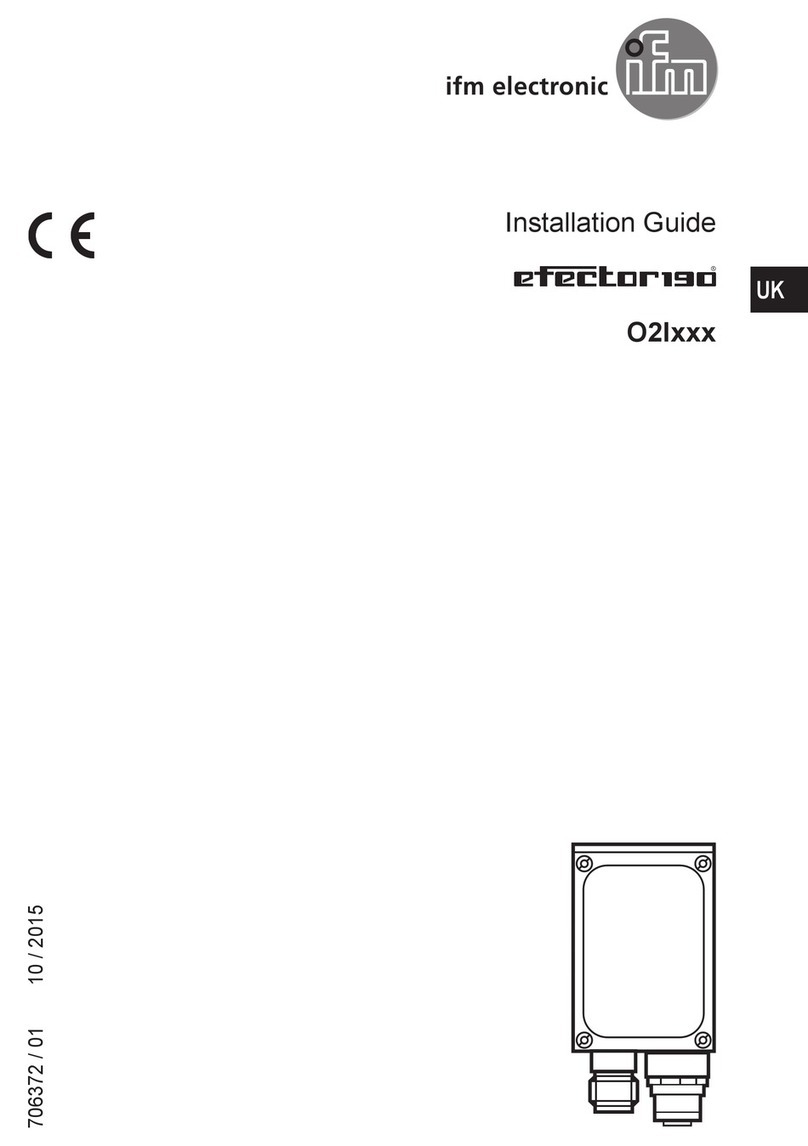
IFM Electronic
IFM Electronic Efector190 O2I Series installation guide
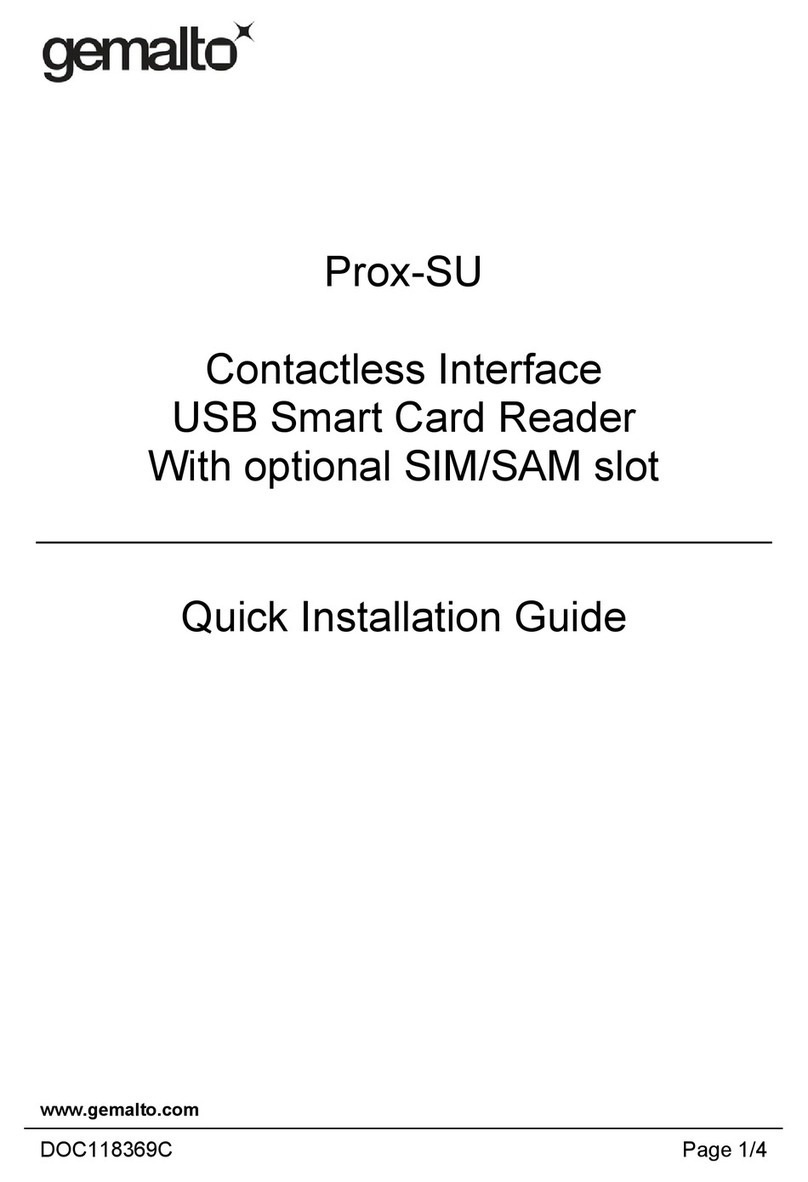
Gemalto
Gemalto Prox-SU Quick installation guide
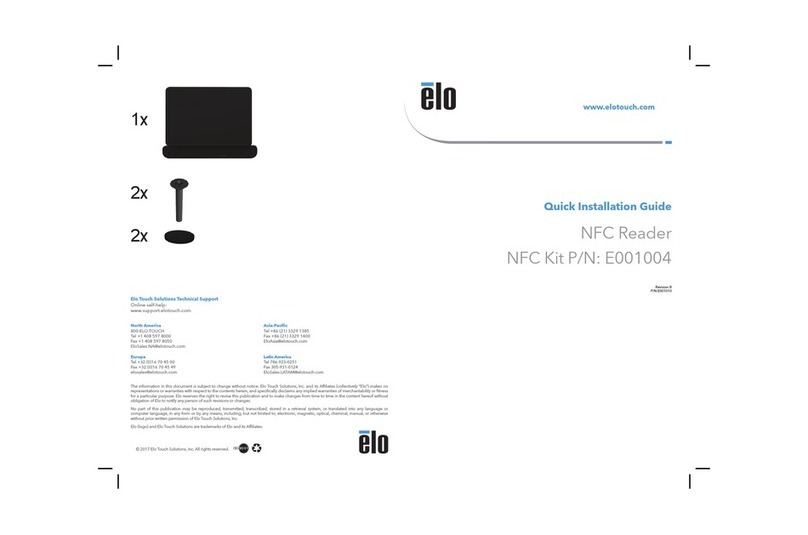
Elo TouchSystems
Elo TouchSystems E001004 Quick installation guide

